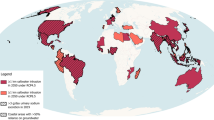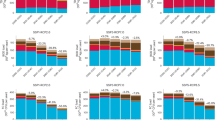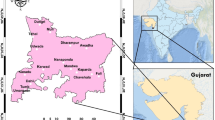Abstract
This study investigates whether active water quality monitoring stations are proportionately distributed across communities of varying social vulnerability. We specifically focus on nutrient monitoring of surface waters in the South Atlantic-Gulf region, a water-rich area with wide-ranging land uses and communities that span the social vulnerability spectrum. We used 2018–2022 data from the US Water Quality Portal to compare station locations to metrics from the US Centers for Disease Control Social Vulnerability Index (SVI) and hydrography from the US Geological Survey. Statistical analyses revealed a substantial imbalance in the distribution of active monitoring station placements, with more monitoring stations in lower vulnerability areas and fewer in high vulnerability areas, and patterns that vary by state. Stations were clustered in areas of similar SVI values; areas were less likely to be monitored if they were near tracts with differing SVI values.
This is a preview of subscription content, access via your institution
Access options
Subscribe to this journal
Receive 12 digital issues and online access to articles
$119.00 per year
only $9.92 per issue
Buy this article
- Purchase on SpringerLink
- Instant access to full article PDF
Prices may be subject to local taxes which are calculated during checkout






Similar content being viewed by others
Data availability
All geospatial data used in our analyses are freely available online from various US government and state agencies and bureaus. The 2022 version of the SVI was used51. The locations of nutrient monitoring water quality stations were downloaded from the US Water Quality Portal45. Hydrography (water body polygons and polylines) data were downloaded from the USGS Best Resolution National Hydrography Dataset via The National Map Download46. Hydrography data were downloaded at the state scale for each of the 9 states in the South Atlantic-Gulf region and clipped using the U.S. Geological Survey Watershed Boundary Dataset, which was also downloaded from The National Map Download. The datasets used in this analysis were the most recent versions as of December 2023, as these datasets are constantly updated. Census tract rurality data were downloaded from the US Health Resources and Services Administration Federal Office of Rural Health Policy29. The rurality data are from 2023 and represent the most recent collection of census-tract-scale rurality data. State boundary shapefiles were downloaded from the US Census Bureau MAF/TIGER geographic database52. The state boundary shapefiles used in our analyses were from 2018 and were at the 1:500,000 scale. The datasets generated for this study are available via Dryad at https://doi.org/10.5061/dryad.7d7wm3858 (ref. 53).
Code availability
All code used for analysis is available via Dryad at https://doi.org/10.5061/dryad.7d7wm3858 (ref. 53).
References
Chapman, D. V. & Sullivan, T. The role of water quality monitoring in the sustainable use of ambient waters. One Earth 5, 132–137 (2022).
Federal Water Pollution Control Act, 33 U.S.C. § 1313(d) (US Government Publishing Office, 1972); https://uscode.house.gov/view.xhtml?req=granuleid:USC-prelim-title33-chapter26&edition=prelim
National Lakes Assessment: The Fourth Collaborative Survey of Lakes in the United States Report No. EPA 841-R-24-006 (Office of Water and Office of Research and Development, US EPA, 2024); https://nationallakesassessment.epa.gov/webreport
Sampling and Consideration of Variability (Temporal and Spatial) for Monitoring of Recreational Waters (US EPA, 2010); https://www.epa.gov/sites/default/files/2015-11/documents/sampling-consideration-recreational-waters.pdf
State of South Carolina Monitoring Strategy For Calendar Year Technical Report No. 003-2025 (South Carolina Department of Environmental Services, Bureau of Water, Aquatic Sciences Division, Aquatic Resource Monitoring Section, 2023); https://dc.statelibrary.sc.gov/items/ca980144-552f-43c8-8f4b-8d27014a1aa6
Ambient Water Quality Monitoring Project Plan (Virginia Department of Environmental Quality, 2024); https://www.deq.virginia.gov/home/showpublisheddocument/4824/638494531427970000
Intensive Survey Branch Standard Operating Procedures Manual: Physical and Chemical Monitoring Version 2.1 (North Carolina Department of Environment and Natural Resources, 2013); https://www.deq.nc.gov/water-quality/environmental-sciences/eco/ams-qapp/appendix-7-isb-sop-ver-2-1-dec-2013/download
Johnson, B. & Bryson, S. Spatial Patterns in Water Quality Portal Data: Identifying and Addressing Gaps in Water Quality Monitoring and Reporting (Nicholas Institute for Energy, Environment & Sustainability, 2022); https://nicholasinstitute.duke.edu/sites/default/files/publications/spatial-patterns-water-quality-portal-data_1.pdf
NWISWeb: New Site For The Nation’s Water Data (USGS, 2016); https://pubs.usgs.gov/fs/fs-128-02/
Wagner, R. J., Boulger, R. W. Jr, Oblinger, C. J. & Smith, B. A. Guidelines and Standard Procedures for Continuous Water-Quality Monitors: Station Operation, Record Computation, and Data Reporting (USGS, 2006); https://doi.org/10.3133/tm1D3
Flanagan, B. E., Gregory, E. W., Hallisey, E. J., Heitgerd, J. L. & Lewis, B. A social vulnerability index for disaster management. J. Homel. Secur. Emerg. Manage. 8, 0000102202154773551792 (2011).
Bakshi, A. et al. Identifying Louisiana communities at the crossroads of environmental and social vulnerability, COVID-19, and asthma. PLoS ONE 17, e0264336 (2022).
Nigra, A. E., Cazacu-De Luca, A. & Navas-Acien, A. Socioeconomic vulnerability and public water arsenic concentrations across the US. Environ. Pollut. 313, 120113 (2022).
Saia, S. M. et al. Applying climate change risk management tools to integrate streamflow projections and social vulnerability. Ecosystems https://doi.org/10.1007/s10021-019-00387-5 (2019).
Díaz Vázquez, J., McCullough, I. M., Haite, M., Soranno, P. A. & Cheruvelil, K. S. US lakes are monitored disproportionately less in communities of color. Front. Ecol. Environ. https://doi.org/10.1002/fee.2803 (2024).
Nutrient Criteria Technical Guidance Manual: Rivers and Streams (US EPA, 2000); https://www.epa.gov/sites/default/files/2018-10/documents/nutrient-criteria-manual-rivers-streams.pdf
National Water Quality Inventory: Report to Congress (US EPA, 2017); https://www.epa.gov/sites/default/files/2017-12/documents/305brtc_finalowow_08302017.pdf
Schaider, L. A., Swetschinski, L., Campbell, C. & Rudel, R. A. Environmental justice and drinking water quality: are there socioeconomic disparities in nitrate levels in U.S. drinking water? Environ. Health 18, 3 (2019).
Balazs, C., Morello-Frosch, R., Hubbard, A. & Ray, I. Social disparities in nitrate-contaminated drinking water in California’s San Joaquin Valley. Environ. Health Perspect. 119, 1272–1278 (2011).
National Academy of Sciences & US EPA Transforming EPA Science to Meet Today’s and Tomorrow’s Challenges (National Academies, 2023); https://doi.org/10.17226/26602
Urban Area Criteria for the 2020 Census—Final Criteria (US Census Bureau & US Department of Commerce, 2022); https://www.federalregister.gov/documents/2022/03/24/2022-06180/urban-area-criteria-for-the-2020-census-final-criteria
Brulle, R. J. & Pellow, D. N. Environmental justice: human health and environmental inequalities. Annu. Rev. Public Health 27, 103–124 (2006).
Koester, S. & Davis, S. Siting of wood pellet production facilities in environmental justice communities in the southeastern United States. Environ. Justice 11, 64–70 (2018).
Wing, S., Cole, D. & Grant, G. Environmental injustice in North Carolina’s hog industry. Environ. Health Perspect. 108, 225–231 (2000).
Ellis, K. Power to the People: Part I (Albemarle-Pamlico National Estuary Partnership, 2019); https://apnep.nc.gov/blog/2019/12/09/power-people-part-i
Pierce, E. et al. Unprecedented toxic blooms of Microcystis spp. in 2019 in the Chowan River, North Carolina. Harmful Algae 140, 102747 (2024).
de Vries, W. Impacts of nitrogen emissions on ecosystems and human health: a mini review. Curr. Opin. Environ. Sci. Health 21, 100249 (2021).
Pennino, M. J., Leibowitz, S. G., Compton, J. E., Hill, R. A. & Sabo, R. D. Patterns and predictions of drinking water nitrate violations across the conterminous United States. Sci. Total Environ. 722, 137661 (2020).
Federal Office of Rural Health Policy (FORHP) Data Files (Health Resources and Services Administration, 2025); https://www.hrsa.gov/rural-health/about-us/what-is-rural/data-files
Tripati, A. et al. Centering equity in the nation’s weather, water, and climate services. Environ. Justice 17, 45–53 (2024).
Biber, E. The problem of environmental monitoring. Colorado Law Rev. 83, 1–82 (2011).
Arciszewski, T. J., Roberts, D. R., Mahaffey, A. & Hazewinkel, R. R. O. Distinguishing between research and monitoring programs in environmental science and management. J. Environ. Stud. Sci. 13, 674–681 (2023).
Emanuel, R. E., Caretta, M. A., Rivers, L. III & Vasudevan, P. Natural gas gathering and transmission pipelines and social vulnerability in the United States. GeoHealth 5, e2021GH000442 (2021).
Lynn, K., MacKendrick, K. & Donoghue, E. M. Social Vulnerability and Climate Change: Synthesis of Literature (Pacific Northwest Research Station, Forest Service, US Department of Agriculture, 2011); https://www.fs.usda.gov/pnw/pubs/pnw_gtr838.pdf
Climate Change and Social Vulnerability in the United States: A Focus on Six Impacts (US EPA, 2021); https://doi.org/10.1163/9789004322714_cclc_2021-0166-513
Oates, C. et al. Effective nutrient management of surface waters in the United States requires expanded water quality monitoring in agriculturally intensive areas. ACS Environ. Au 5, 1–11 (2024).
Cooperative Projects. USGS; https://www.usgs.gov/programs/national-water-quality-program/cooperative-projects (2024).
Mahmoudi, D. et al. Mapping for whom? Communities of color and the citizen science gap. ACME 21, 327–336 (2022).
Saywitz, R. R. & Teodoro, M. P. Which drains get claimed? Adopt-a-drain programs in three US cities. J. AWWA https://doi.org/10.1002/awwa.1671 (2021).
Robinson, W. R., Renson, A. & Naimi, A. I. Teaching yourself about structural racism will improve your machine learning. Biostatistics 21, 339–344 (2019).
Parmar, T. K., Rawtani, D. & Agrawal, Y. K. Bioindicators: the natural indicator of environmental pollution. Front. Life Sci. 9, 110–118 (2016).
Everall, N. C. et al. Macroinvertebrate community structure as an indicator of phosphorus enrichment in rivers. Ecol. Indic. 107, 105619 (2019).
Seaber, P. R., Kapinos, F. P. & Knapp, G. L. Hydrologic Unit Maps Paper No. 2294 (US Government Printing Office, 1987); https://pubs.usgs.gov/wsp/wsp2294/pdf/wsp_2294.pdf
Van den Bossche, J. et al. geopandas/geopandas: v0.13.2. Zenodo. https://doi.org/10.5281/zenodo.8009629 (2023).
Water Quality Portal (US EPA, 2023); https://www.waterqualitydata.us/
TNM Download v2.0 (USGS, 2023); https://apps.nationalmap.gov/downloader/
Horton, R. Drainage-basin characteristics. Eos 13, 350–361 (1932).
QGIS 3.32 (QGIS, 2023); https://download.qgis.org/downloads/qgis-3.32.2.tar.bz2
R v.4.3.1 (R Foundation for Statistical Computing, 2023); https://www.r-project.org/about.html
Getis, A. in Handbook of Applied Spatial Analysis: Software Tools, Methods and Applications (eds Fischer, M. M. & Getis, A.) 255–278 (Springer, 2010).
CDC/ATSDR Social Vulnerability Index 2022 Database U.S. (Centers for Disease Control and Prevention/ Agency for Toxic Substances and Disease Registry/ Geospatial Research, Analysis, and Services Program, accessed 5 October 2023); https://www.atsdr.cdc.gov/placeandhealth/svi/data_documentation_download.html
Cartographic Boundary Files - Shapefile. (US Census Bureau, accessed 21 November 2023); https://www.census.gov/geographies/mapping-files/time-series/geo/carto-boundary-file.html
Oates, C. C., Grieger, K., Emanuel, R. & Nelson, N. G. Dataset: surface waters in socially vulnerable areas are disproportionately under-monitored for nutrients in the U.S. South Atlantic-Gulf Region. Dryad https://doi.org/10.5061/dryad.7d7wm3858 (2025).
Acknowledgements
We gratefully acknowledge support for this work provided by the Science and Technologies for Phosphorus Sustainability (STEPS) Center, funded by the US National Science Foundation (grant no. CBET-2019435). C.C.O., K.G. and N.G.N. were supported by the STEPS Center. We also acknowledge USDA NIFA Hatch projects (accession number 7003378, multistate project S1089; and research project number 7009573, associated with N.G.N. and K.G.).
Author information
Authors and Affiliations
Contributions
K.G. and N.G.N. obtained the funding for the project. C.C.O. and N.G.N. designed the study. N.G.N. supervised the study. C.C.O. conducted the data analysis and prepared the figures. C.C.O., K.G., R.E. and N.G.N. drafted, reviewed and finalized the paper.
Corresponding authors
Ethics declarations
Competing interests
The authors declare no competing interests.
Peer review
Peer review information
Nature Water thanks Richard Milligan and the other, anonymous, reviewer(s) for their contribution to the peer review of this work.
Additional information
Publisher’s note Springer Nature remains neutral with regard to jurisdictional claims in published maps and institutional affiliations.
Supplementary information
Rights and permissions
Springer Nature or its licensor (e.g. a society or other partner) holds exclusive rights to this article under a publishing agreement with the author(s) or other rightsholder(s); author self-archiving of the accepted manuscript version of this article is solely governed by the terms of such publishing agreement and applicable law.
About this article
Cite this article
Oates, C.C., Grieger, K., Emanuel, R. et al. Surface waters in socially vulnerable areas are disproportionately under-monitored for nutrients in the US South Atlantic-Gulf region. Nat Water 3, 831–840 (2025). https://doi.org/10.1038/s44221-025-00460-5
Received:
Accepted:
Published:
Issue date:
DOI: https://doi.org/10.1038/s44221-025-00460-5



